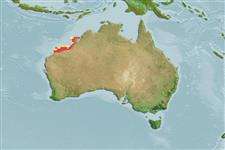Environment: milieu / climate zone / depth range / distribution range
Ecología
marino asociado a arrecife; rango de profundidad 4 - 50 m (Ref. 5222). Tropical; 16°S - 22°S, 116°E - 124°E (Ref. 5222)
Eastern Indian Ocean: known only from Western Australia. Was illustrated in color as Epinephelus maculatus by Allen (1985, Ref. 1677) and Sainsbury et al. (1985, Ref. 3131). This species have been much confused with other 'reticulated groupers' in literature, and many museum specimens have been misidentified.
Tamaño / Peso / Age
Maturity: Lm ? range ? - ? cm
Max length : 33.0 cm TL macho / no sexado; (Ref. 5222)
Espinas dorsales (total): 11; Radios blandos dorsales (total): 17-18; Espinas anales 3; Radios blandos anales: 8. Characterized by: greyish-brown color overall with hexagonal brown spots; white strip at back; dorsal fin base with 2-3 dark bilobed spots; body scales ctenoid, cycloid scales anterodorsally on thorax and ventrally on abdomen; body with auxiliary scales; greatest depth of body 2.8-3.3 in SL; rounded caudal fin; pelvic fins 1.8-2.1 in head length (Ref. 90102); preopercle subangular, with serrae at the angle slightly enlarged; opercular spines inconspicuous; straight or slightly concave upper edge of operculum; nostrils subequal in small fish, but posterior nostril diameter about twice of that of anterior nostril in a fish of 27 cm SL; maxilla reaches below rear half of eye; 2 rows of small teeth on midlateral part of lower jaw (Ref. 089707).
No fishery information is available. Found on coral reefs or rocky bottom (Ref. 089707). No published information on its biology. Solitary (Ref 90102).
Life cycle and mating behavior
Madurez | Reproducción | Puesta | Huevos | Fecundidad | Larva
Heemstra, P.C. and J.E. Randall, 1993. FAO Species Catalogue. Vol. 16. Groupers of the world (family Serranidae, subfamily Epinephelinae). An annotated and illustrated catalogue of the grouper, rockcod, hind, coral grouper and lyretail species known to date. Rome: FAO. FAO Fish. Synop. 125(16):382 p. (Ref. 5222)
IUCN Red List Status (Ref. 130435)
Threat to humans
Harmless
Human uses
Más información
Nombres comunesSinónimosMetabolismoDespredadoresEcotoxicologíaReproducciónMadurezPuestaAgregación para la puestaFecundidadHuevosEgg development
ReferenciasAcuiculturaPerfil de acuiculturaRazasGenéticaElectrophoresesheritabilidadEnfermedadesProcesamientoNutrientsMass conversion
ColaboradoresImágenesStamps, Coins Misc.SonidosCiguateraVelocidadTipo de nataciónSuperficie branquialOtolitosCerebrosVisión
Herramientas
Special reports
Download XML
Fuentes de Internet
Estimates based on models
Preferred temperature (Ref.
123201): 26.4 - 28, mean 26.8 °C (based on 22 cells).
Phylogenetic diversity index (Ref.
82804): PD
50 = 0.5000 [Uniqueness, from 0.5 = low to 2.0 = high].
Bayesian length-weight: a=0.01175 (0.00571 - 0.02419), b=3.04 (2.88 - 3.20), in cm total length, based on LWR estimates for this Genus-body shape (Ref.
93245).
Nivel trófico (Ref.
69278): 3.7 ±0.5 se; based on size and trophs of closest relatives
Resiliencia (Ref.
120179): Medio, población duplicada en un tiempo mínimo de 1.4-4.4 años (Preliminary K or Fecundity.).
Fishing Vulnerability (Ref.
59153): Low vulnerability (23 of 100).
Nutrients (Ref.
124155): Calcium = 38.2 [18.7, 77.5] mg/100g; Iron = 0.535 [0.293, 1.100] mg/100g; Protein = 18.5 [17.0, 19.8] %; Omega3 = 0.132 [0.084, 0.206] g/100g; Selenium = 29.9 [17.5, 51.7] μg/100g; VitaminA = 228 [64, 811] μg/100g; Zinc = 1.44 [0.99, 2.00] mg/100g (wet weight);
